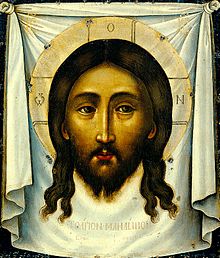
Acheiropoieta (Medieval Greek: αχειροποίητα, 'made without hand'; singular acheiropoieton) — also called icons made without hands (and variants) — are Christian icons which are said to have come into existence miraculously; not created by a human. Invariably these are images of Jesus or the Virgin Mary. The most notable examples that are credited by tradition among the faithful are, in the Eastern church, the Mandylion,[1] also known as the Image of Edessa, and the Hodegetria, and several Russian icons, and in the West the Shroud of Turin, Veil of Veronica, Our Lady of Guadalupe, and the Manoppello Image. The term is also used of icons that are only regarded as normal human copies of a miraculously created original archetype.
Although the most famous acheiropoieta today are mostly icons painted on wood panel, they exist in other media, such as mosaics, painted tile, and cloth. Ernst Kitzinger distinguished two types: "Either they are images believed to have been made by hands other than those of ordinary mortals or else they are claimed to be mechanical, though miraculous, impressions of the original".[2] The belief in such images became prominent only in the 6th century, by the end of which both the Mandylion and the Image of Camuliana were well known. The pilgrim Antoninus of Piacenza was shown a relic of the Veil of Veronica type in Memphis, Egypt in the 570s.[3]
- ^ Guscin, Mark (2016-02-08). The Tradition of the Image of Edessa. Cambridge Scholars Publishing. p. 137. ISBN 9781443888752.
- ^ Kitzinger, 113
- ^ Kitzinger, 113–114